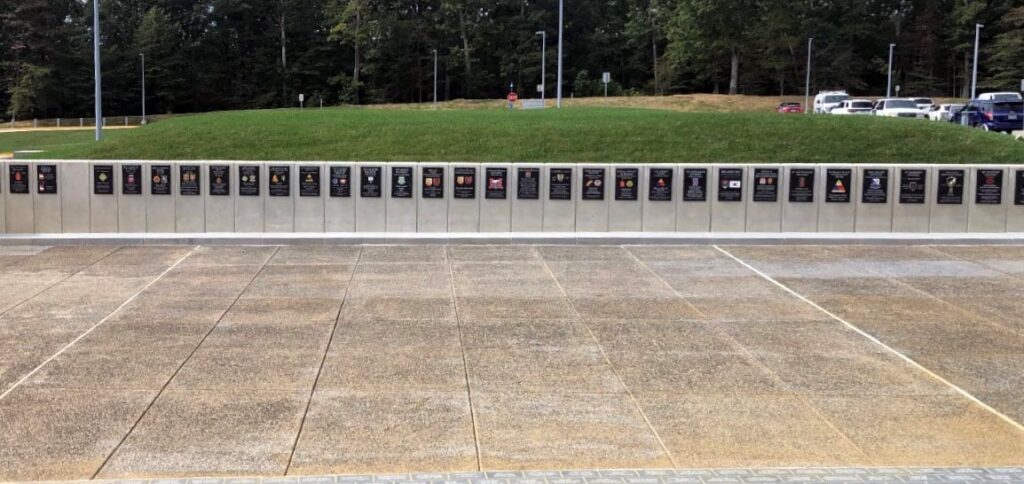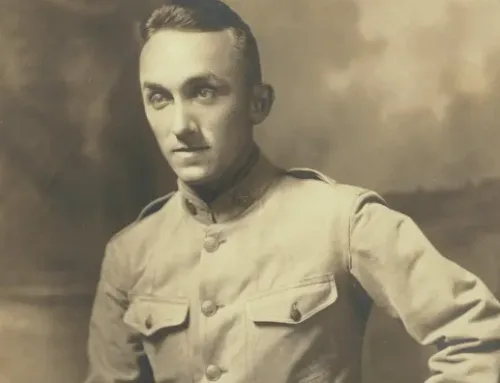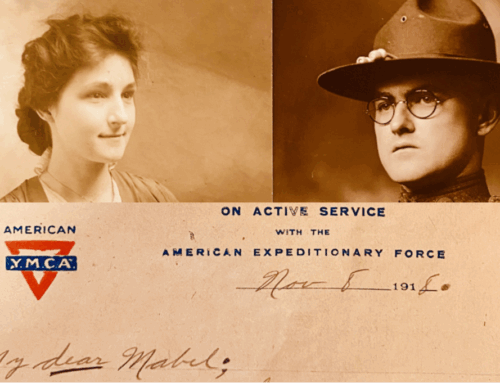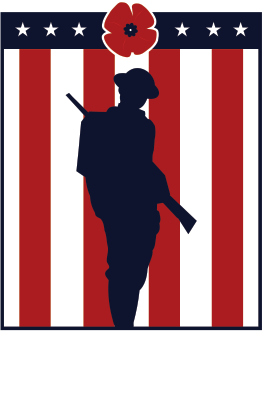Sites created to install Unit Tributes at the National Museum of the US Army, Fort Belvoir, VA, for the WWI 92nd Infantry Division and 93rd Infantry Division
Published: 4 October 2025
By Dianne Smith
Special to the Doughboy Foundation website

Hello Girls Unit Plaque 1
National Museum of the United States Army, Fort Belvoir, VA
The National Museum of the United States Army at Fort Belvoir, VA, is an award-winning facility with the theme “Soldiers Stories,” highlighting the experiences of the men and women who have served since 1775. Along the walkway from the parking lot is a Wall of Honor holding Unit Tributes to active and historic military units. Two sites have been established to raise money to create and install Unit Tributes for the two African-American divisions which fought in World War I.
Unit Tribute Plaques at NMUSA
When the Civil War ended, the US Army created six (later consolidated to four) African-American regiments, numbering about a quarter of the total of the post-war Army. Yet, when the US entered World War I, the Army saw fit to deploy those units along the southern border and the Philippines and to create two African American divisions and transfer 1,600 soldiers to their ranks: the 92nd Division under US command and the 93rd Division, which was parceled out to foreign command.
92nd Infantry Division “The Buffalo Soldiers”
 The division was organized in October 1917 at Camp Funston, Kansas, with African American soldiers from all states. Recruitment and training did not prepare them well for combat. They were given neither adequate bathing facilities or clean uniforms. With training dispersed, there was no common standard: some soldiers received full combat training, while others were only assigned menial duties. Initial efforts to train black officers faltered with the decision to rely on white officers, often southerners “who understood how to treat Negroes,” who regarded being assigned to black units as demeaning and ruinous to their careers. Under the command of Major General Charles Ballou, who condoned segregation “to support good order and discipline”, the 92nd arrived in France with the joining of separate parts which had never trained as a division before, so there was no unit cohesion. Upon arrival, they were first used as stevedores, then very limited combat training which delayed their deployment until June. Another purge of black officers was followed by again limited combat training, and it was not until the end of August that the 92nd was first sent to the St. Die sector in Lorraine, near the Rhine River, southeast of Metz. During their first action at the end of August, they successfully assaulted German positions and drove back counterattacks despite bombardment of 12,000 shells in 2 ½ hours. They were then shifted to patrolling until 20 September when ordered to the Argonne Forest.
The division was organized in October 1917 at Camp Funston, Kansas, with African American soldiers from all states. Recruitment and training did not prepare them well for combat. They were given neither adequate bathing facilities or clean uniforms. With training dispersed, there was no common standard: some soldiers received full combat training, while others were only assigned menial duties. Initial efforts to train black officers faltered with the decision to rely on white officers, often southerners “who understood how to treat Negroes,” who regarded being assigned to black units as demeaning and ruinous to their careers. Under the command of Major General Charles Ballou, who condoned segregation “to support good order and discipline”, the 92nd arrived in France with the joining of separate parts which had never trained as a division before, so there was no unit cohesion. Upon arrival, they were first used as stevedores, then very limited combat training which delayed their deployment until June. Another purge of black officers was followed by again limited combat training, and it was not until the end of August that the 92nd was first sent to the St. Die sector in Lorraine, near the Rhine River, southeast of Metz. During their first action at the end of August, they successfully assaulted German positions and drove back counterattacks despite bombardment of 12,000 shells in 2 ½ hours. They were then shifted to patrolling until 20 September when ordered to the Argonne Forest.
They arrived just on the eve of battle, with no time to acclimatize or gain familiarity with the rough, broken terrain. They lacked experience or training as a liaison unit. Headquarters failed to provide them with grenade launchers, signal flares, wire cutters, or maps and they had no specific objectives. The US artillery barrage failed to destroy heavily wired enemy positions, and they faced German heavy machine gun and artillery fire, plus huge craters from earlier fighting. Under terrible conditions in wooded terrain, one regiment broke and retreated in turmoil. Because of their perceived poor performance, the entire division was relieved and sent to a “quiet sector,” where their heavy patrolling resulted in 462 American casualties in one month. The division was ordered to assault heavily defended enemy heights on 10 November, again suffering over 500 American casualties, mostly from poison gas, during the unnecessary attack, as the Armistice was declared the next day. All other combat, combat support, and logistics units were praised; the 367th Regiment received a unit Croix de Guerre for their drive toward Metz and 57 members of division received the Distinguished Service Cross. Nevertheless, military authorities, especially white officers within the discredited 368th Regiment instituted a campaign to discredit their troops to push off blame for their own poor performance and explain units’ problems as “cowardly” behavior of black officers.
During subsequent internal military trials, 30 African American officers were relieved from duty, and five officers were court martialed. However, an official inquiry exonerated the 368th Regiment of any cowardice and ascribed failure due to poor training, poor equipment, poor logistical support, and scapegoating. The division was deactivated in February 1919.
93rd Infantry Division
 The 93rd Division was organized at Camp Stuart, Newport News, Virginia, in December 1917. The unit was unique in that it was limited to four infantry regiments (three from National Guard units from New York, Illinois, Ohio, Maryland, Tennessee, Connecticut, Massachusetts, and Washington, DC) and one regiment from North and South Carolina. Thus, it lacked uniformity in its experience and leadership (white officers with a few African Americans in junior grades), and lacked artillery brigades, divisional troops or trains, and a full complement of combat units and support elements. It never attained full divisional strength and never really functioned as a division. Instead, the 369th, 370th, 371st and 372nd Regiments were offered up to the exhausted and depleted French Army, which then trained them, equipped them, fed them, deployed them, commanded them, and rewarded them. As a result, the adopted the blue French helmet as their division symbol. The four regiments were parceled out to different divisions and never fought together. Three of them served very close-by in the Champagne and the fourth served north of the Marne. For their valor, the regiments were showered with honors to include the French Legion of Honor, 75 Distinguished Service Crosses and 527 Croix de Guerre medals, making the 93rd Division one of the most highly honored in Army history. A white officer, First Lieutenant George Robb was awarded the Medal of Honor in 1919. It would take decades before the US Army bestowed Medals of Honor on Corporal Freddie Stowers (1991) and Sergeant Henry Johnson (2015). The fame of the 369th Regiment “Harlem Hellfighters” and their military band under Lieutenant James Europe, credited with introducing Jazz to France, are more well known today, but all four regiments had remarkable records fighting under the French, as compared to its counterpart, the 92nd Division, which suffered under US leadership. The division was deactivated in 1919.
The 93rd Division was organized at Camp Stuart, Newport News, Virginia, in December 1917. The unit was unique in that it was limited to four infantry regiments (three from National Guard units from New York, Illinois, Ohio, Maryland, Tennessee, Connecticut, Massachusetts, and Washington, DC) and one regiment from North and South Carolina. Thus, it lacked uniformity in its experience and leadership (white officers with a few African Americans in junior grades), and lacked artillery brigades, divisional troops or trains, and a full complement of combat units and support elements. It never attained full divisional strength and never really functioned as a division. Instead, the 369th, 370th, 371st and 372nd Regiments were offered up to the exhausted and depleted French Army, which then trained them, equipped them, fed them, deployed them, commanded them, and rewarded them. As a result, the adopted the blue French helmet as their division symbol. The four regiments were parceled out to different divisions and never fought together. Three of them served very close-by in the Champagne and the fourth served north of the Marne. For their valor, the regiments were showered with honors to include the French Legion of Honor, 75 Distinguished Service Crosses and 527 Croix de Guerre medals, making the 93rd Division one of the most highly honored in Army history. A white officer, First Lieutenant George Robb was awarded the Medal of Honor in 1919. It would take decades before the US Army bestowed Medals of Honor on Corporal Freddie Stowers (1991) and Sergeant Henry Johnson (2015). The fame of the 369th Regiment “Harlem Hellfighters” and their military band under Lieutenant James Europe, credited with introducing Jazz to France, are more well known today, but all four regiments had remarkable records fighting under the French, as compared to its counterpart, the 92nd Division, which suffered under US leadership. The division was deactivated in 1919.
The racism they faced during the war continued into the peace. In 1920, when the army’s authority to maintain Jim Crow regulations seemed threatened, Major General Charles Martin wrote that “the negro is of very little importance… the average negro is not by any means equal to the average white man. An Army War College board in 1925 warned that military service would produce demands for equality, but that should not be allowed to happen. The study saw fit to judge the behavior of one lone regiment within two division in one action as proving the inferiority of all black soldiers, the need to segregate units by race, and the necessity to put limits on black officers by position and rank. It said “negroes” would not follow black officers in battle, only white commanders. It argued the Army should never place black officers over white officers or troops. It was a blueprint for continued institutional racism in the interwar period and warped the handling of the two divisions when they were reactivated in World War II. Some argue these the fought war on two fronts: against the Germans and against the Army hierarchy which needed the manpower but distained their service. But they fought bravely for their country and deserve plaques on the Wall of Honor at the National Museum of the US Army.
Plaques are created and paid for by private donation. We sponsored a plaque for the WWI “Hello Girls”; now we want to do the same for the 92nd and 93rd Infantry Divisions. You can submit a donation for the plaque by check or credit card. If by check, please make it payable to: “National Army Museum Fund” and write “92nd Infantry Division” or “93rd Infantry Division” on the memo line. Mail to: Army Historical Foundation ATTN: Delvon Lukyamuzi 1775 Liberty Drive, Ste 400 Fort Belvoir, VA 22060. If paying by credit card, use the online fundraising page for each: https://armyhistory.causevox.com/92nd_Infantry_Division or https://armyhistory.causevox.com/93rd_Infantry_Division You can also call the Army Historical Foundation’s direct at (703) 562-4174. Thank you for your support.
External Web Site Notice: This page contains information directly presented from an external source. The terms and conditions of this page may not be the same as those of this website. Click here to read the full disclaimer notice for external web sites. Thank you.




